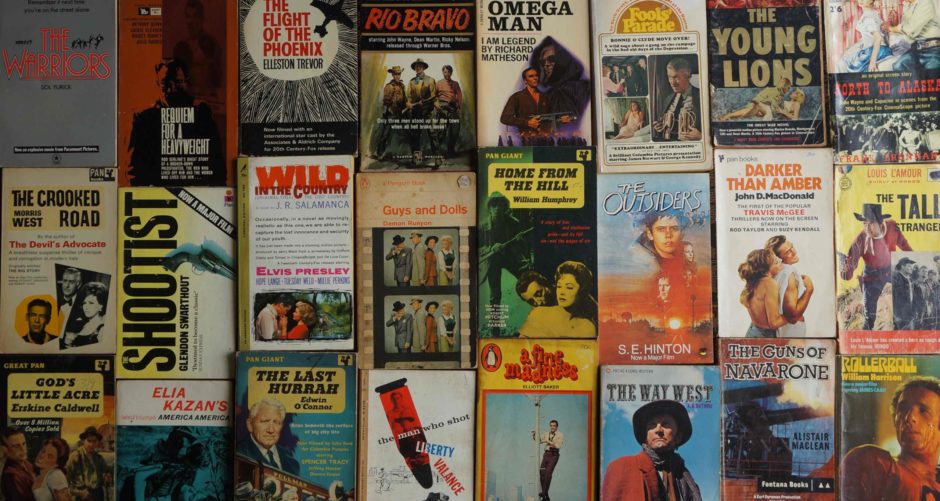FILM DIRECTOR: John Ford
SCREENWRITER: Frank S. Nugent
FILM STARS: James Stewart, Richard Widmark, Shirley Jones, Linda Cristal, Andy Devine, John McIntire, Paul Birch, Willis Bouchey, Henry Brandon, Harry Carey Jr., Olive Carey, Ken Curtis, Anna Lee, Jeanette Nolan, John Qualen
COUNTRY: USA
THIS BOOK
AUTHOR: Will Cook
TYPE: Novel
PUBLISHER: Bantam
THIS EDITION PUBLISHED: 1961
COUNTRY: USA
COVER: Paperback
THE ORIGINAL BOOK
ORIGINAL AUTHOR: As Above
YEAR FIRST PUBLISHED: 1959
ORIGINAL BOOK TITLE: Comanche Captives
NOTES
GENRE: Western
WORDS: The American west in film (and in literature) has been the black and white battle ground between concepts of good and evil even if the protagonists are grey. Its landscape is usually stripped of laws (or at least established accessible laws), is remote (where things can go hidden), and is a place where undesired consequences don’t always follow anti-social acts. It becomes a place where human emotions and personal philosophies can be viewed without the garments of “civilisation”. The clash of the new, of different cultures and the changes time itself brings just adds to the fun.
More than any other genre the western is a place where actions have reactions, and both could end in death. I think this occurs because the western is the setting for the last place where everyday people could carry weaponry in the open … and could use the same. It’s a place where the violent reactionary past of humanity meets the beginnings of modern liberal civilisation.
The beauty is, though, the west, like everything, isn’t black and white.
Cook’s novel, “Comanche Captives” (1959) seems to be a follow on to Alan Le May’s “The Searchers” (written 1954, filmed by John Ford in 1956). “The Searchers” is all about the quest to recover white captives taken by Comanche Indians. “Two Rode Together” starts with the recovery of the white captives. The rest is about how they fit in. Both stories are based on real life (and relatively) common place incidents through out the south west of the time. Cook’s book is grim but entertaining, as westerns had to be. Readers wanted action with their philosophical discussion, or, rather, they wanted action to hide any philosophy. It’s a great read.
In both the film and book two different philosophical types are sent to negotiate with Comanche chief Henry Brandon (who was also the chief in “The Searchers”) as Chief Quanah Parker for the release of prisoners. In history Chief Quanah Parker was the half native American son of the girl stolen by the Comanches (which is the basis for “The Searchers”). So if you want to look at this in a meta way. Henry Brandon here (in “Two Rode Together”) is playing the son of the girl stolen by an Indian, played by Henry Brandon (in “The Searchers”).
Quannah Parker’s story (and he himself) is well known in the south west. Recently the wonderful non-fiction “The Searchers: The Making of an American Legend” (2013) by Glenn Frankel tied up history, literature and film. The book (just like the novels), in its treatment of history pulls no punches on the relationships between whites and native Americans, unlike films and television of the time. There is no desire to turn the Comanches into a Native American version of the Cunningham family of the Cosby family (which was what, for all the right reasons, the film “Broken Arrow” (1950), with Jimmy Stewart in the lead, did, and set a trend for). Ford’s film however reflects the unpleasant history.
To some it may be violent and reactionary but to portray protagonists in other ways would be unkind to history, legend or not. There is some darkness in Ford’s west in “The Searchers”, especially with John Wayne’s character , though ultimately, as a character says “this can still be a fine land”. “Two Rode Together” is perhaps Ford’s first totally dark western. That’s not to say there is no humour but it is still philosophically cynical.
Stewart is the cynical marshal hired to repatriate pioneer children captured by the Comanche, and Widmark is the cavalry officer who accompanies him. The captives, the Indians, the soldiers, and the settlers all are victims of the frontier. Westerners, Native Americans (both proto capitalists of different “tribes”) compete with new migrants, and with Easterners for a piece of the action. Gone is the clean frontier as a would-be potential garden of “The Searchers” and earlier Ford films. Instead, Ford offers us a nightmare vision, the frontier overrun by hysteria and (Eastern/Yankee) hypocrisy, with even the Indians seen as primitive entrepreneurs. It is an unsettling film. By all account Ford was unhappy with the film., and he said as much. He may have been but what the famously cantankerous Ford said should be taken with a grain of salt. He had everything he liked including supporting roles populated with Ford regulars and Frank Nugent who was brought in to write the screenplay (he wrote many Ford films and worked on “The Searchers”).
I love this films. It has flaws but it has more merits … the relationship between Stewart and Widmark and their different ideals (in the film they play each others normal roles) is funny but pointed. There are many great scenes – their riverfront dialogue exchange has been mentioned by others and is a classic.
It was called “second rate John Ford” but second rate Ford is far better than first rate from 90% of directors. This neglected Western repays careful attention.
LINKS
TRAILER
two reissue trailers (the first for the DVD release and the second for cable) which are clearly aimed at different audiences (or have different philosophies)



yep re Kirk … no one pushes Kirk around. His Bryna Production Company was involved with (partially funded) POG ..and…